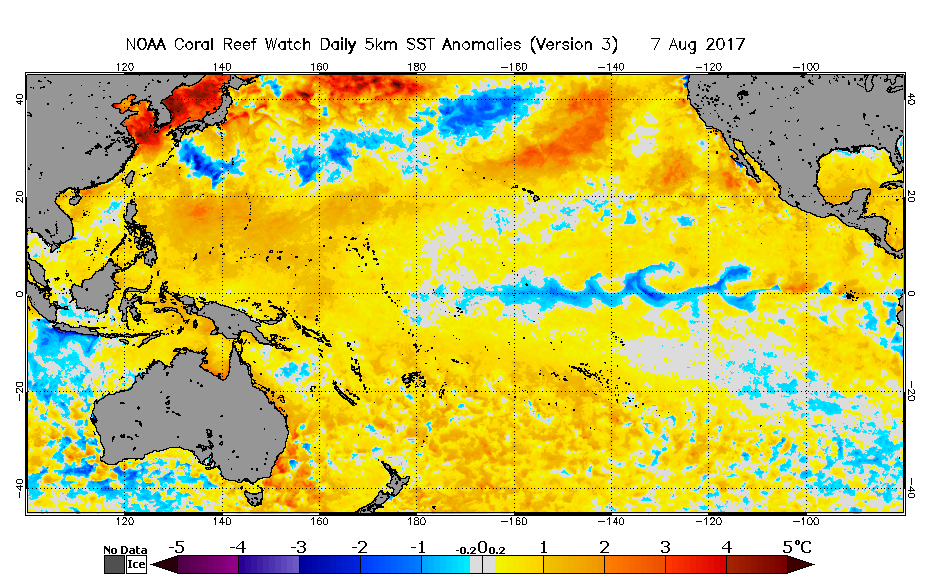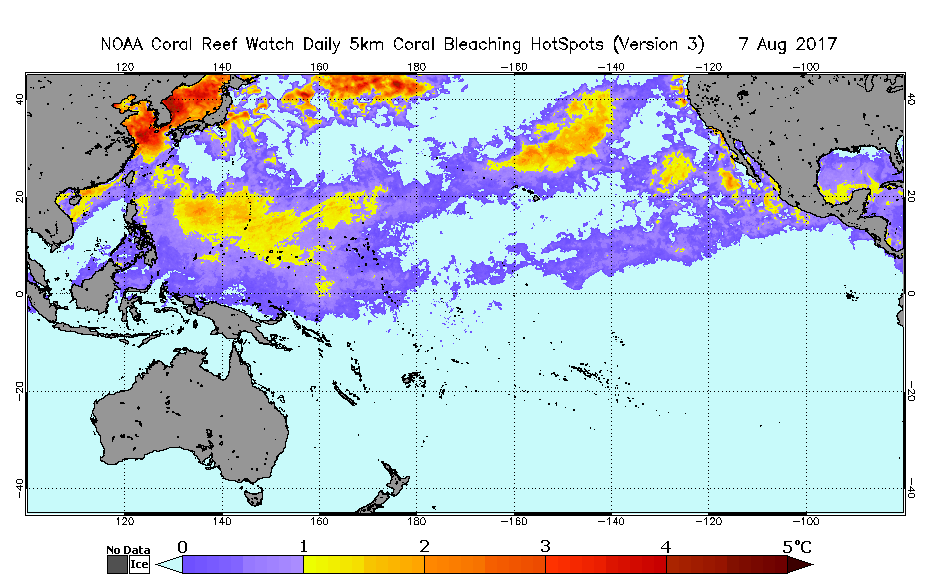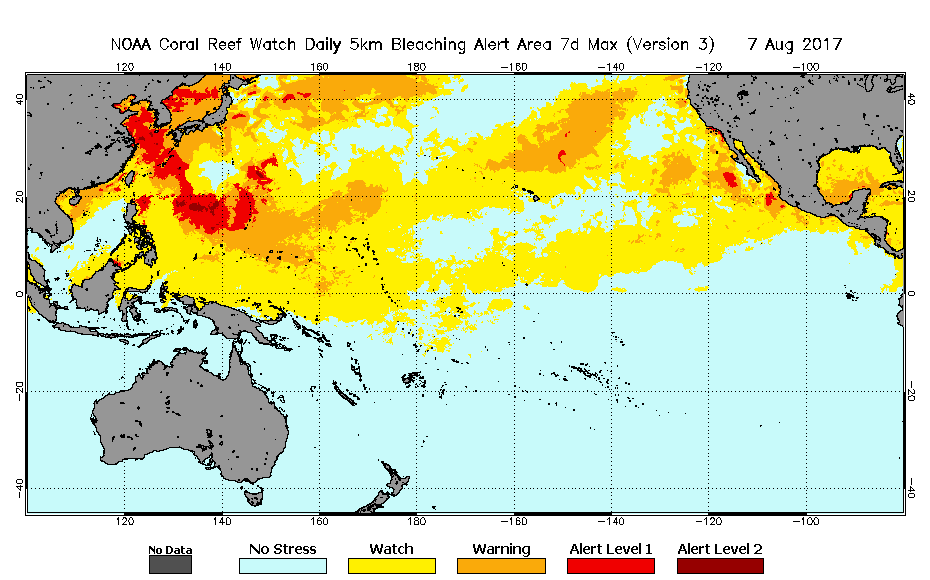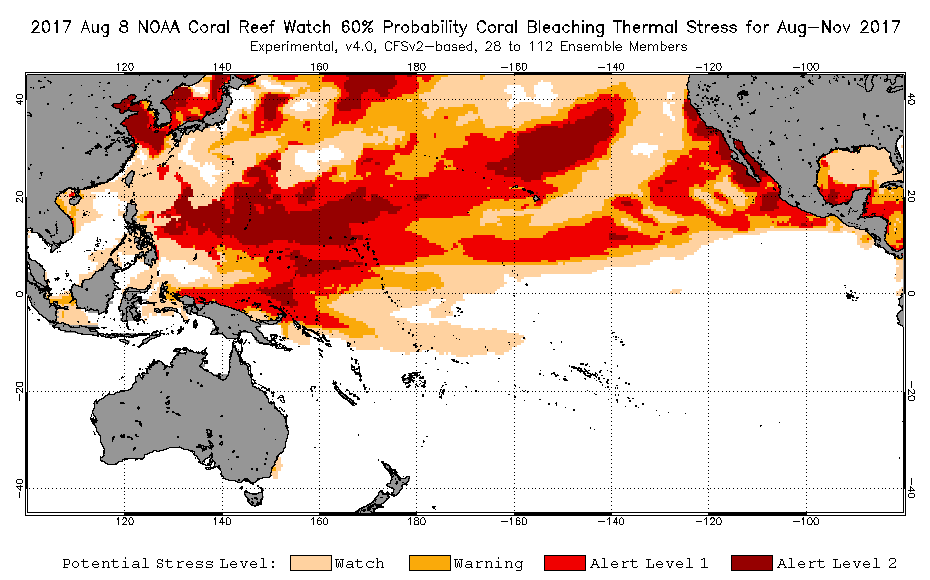Coral Bleaching Heat Stress Analysis and
Seasonal Guidance through November 2017
(Released August 8, 2017)
Current conditions:
NOAA Coral Reef Watch's (CRW) near-real-time satellite monitoring shows moderately above-average sea surface temperature (SST) across most of the Pacific Ocean (Figure 1), with the exception of the southeast Pacific, central equatorial Pacific, and northwest of the Hawaiian Islands archipelago and Ogasawara Islands of Japan. As of July 13, 2017, the NOAA National Centers for Environmental Prediction's El Niño-Southern Oscillation (ENSO) Alert System continues in a "Not Active" status. ENSO-neutral conditions are favored to remain into Northern Hemisphere winter 2017-18.
In June 2017, NOAA declared the Third Global Coral Bleaching Event was likely coming to an end. While the multi-basin scale bleaching event seems to have concluded, CRW's satellite monitoring and Four-Month Bleaching Outlook indicate mass bleaching will continue in the North Pacific Ocean through the boreal summer season, including in Guam and the Commonwealth of the Northern Mariana Islands (CNMI), the Hawaiian Islands, and the Ryukyu Islands in Japan. The severity and timing of coral bleaching in each location are still unfolding.

|
||
|
Figure 1. NOAA Coral Reef Watch's Satellite Sea Surface Temperature (SST) Anomaly product for the Pacific region. |
||
HotSpots (Figure 2) are accumulating around Guam, the CNMI, and the Ryukyu Islands, which have reached Alert Level 1 status (Figure 3). The Federated States of Micronesia and Wake Atoll are at a Bleaching Warning and the Main and Northwestern Hawaiian Islands are both currently at a Bleaching Watch (Figure 3). The northern Philippines and many of the central Pacific nations from the Marshall Islands to the northern Line Islands are at a Bleaching Watch, but the Philippines likely had some coral bleaching in June and July as Alert Level 2 was reached.

|
||
|
Figure 2. NOAA Coral Reef Watch's Satellite Coral Bleaching HotSpot product for the Pacific region. |
||

|
||
|
Figure 3. NOAA Coral Reef Watch's Satellite Bleaching Alert Area (7-day maximum) product for the Pacific region. |
||
CRW's most recent Four-Month Coral Bleaching Heat Stress Outlook (Figure 4) projects heat stress in Guam and the CNMI to continue and increase through October. The northern half of the Main Hawaiian Islands is expected to reach Alert Level 2 by October, and the Northwestern Hawaiian Islands may reach Alert Level 1. The Federated States of Micronesia are predicted to hit Alert Level 1 by mid-October as well; these conditions may persist through November 2017.

|
||
|
Figure 4. NOAA Coral Reef Watch's Four-Month Coral Bleaching Heat Stress Outlook for August-November 2017 for the Pacific region. |
||
NOTE: This report focuses on NOAA Coral Reef Watch's Version 3.0 (or v3) 5km satellite-based coral bleaching heat stress products and v4 Four-Month Coral Bleaching Heat Stress Outlook. The 5km satellite products presented here use CRW's new color scales, which are implemented in the images posted on the CRW website.
To monitor the intensity and location of bleaching heat stress in your coral reef region of interest, please follow NOAA Coral Reef Watch's satellite monitoring and outlooks closely in the coming weeks: https://coralreefwatch.noaa.gov/satellite/bleaching5km/index.php and https://coralreefwatch.noaa.gov/satellite/bleachingoutlook_cfs/outlook_cfs.php.
CRW's current satellite and modeled products can be found at:
https://coralreefwatch.noaa.gov/satellite/index.php
CRW's Four-Month Coral Bleaching Heat Stress Outlooks can be found at:
https://coralreefwatch.noaa.gov/satellite/bleachingoutlook_cfs/outlook_cfs.php
CRW's 5km satellite Regional Virtual Stations can be found at:
https://coralreefwatch.noaa.gov/vs/index.php
Sign up for automated bleaching alert emails for CRW's 5km Regional Virtual Stations at:
http://coralreefwatch-satops.noaa.gov/
CRW's 50km satellite Virtual Stations can be found at:
https://coralreefwatch.noaa.gov/satellite/vs.php
Please report bleaching events (or non-events) at:
https://coralreefwatch.noaa.gov/satellite/research/coral_bleaching_report.php
Disclaimer
The content posted on this web page solely represents the opinions of the authors and does not constitute a statement of policy, decision, or position on behalf of NOAA or the US Government.
The appearance of external links on this World Wide Web site does not constitute endorsement by the Department of Commerce/National Oceanic and Atmospheric Administration of external Web sites or the information, products or services contained therein. For other than authorized activities, the Department of Commerce/NOAA does not exercise any editorial control over the information you may find at these locations. These links are provided consistent with the stated purpose of this Department of Commerce/NOAA Web site.